| enter keyword to search: |
|
Images db
|
|
|
Articles db
|
|
|
|
|
| Sri Lankan Art and Architecture |
|
| Theravada Buddhism Religious Art |
|
Primarily influenced by Theravada Buddhism the island’s religious art is enriched by the influence of Hinduism consequence of the Tamil invasions of the tenth century.
Dambulla |
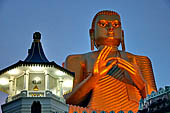
|
Dagobas
The stupa, the world wide aniconic architectural representation of the Buddha, is known in Sri Lanka as dagoba. The shape of the dagobas derives directly from the great stupa of Sanchi (India) with some subtle variations. Big dagobas can be seen at Polonnaruwa (Rankot Vihara, Kiri Vihara). The entire structures were plastered and painted with a coat of lime-wash. Four small shrines (vahalkadas) are sometimes present at the four cardinal points.
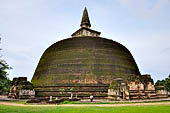
|
Polonnaruwa
|
Buddhist temples
Sri Lankan Buddhist temples (viharas or viharayas) range from the cave temples of Dambulla and Mulkirigala, to the monastic foundations of Polonnaruwa, to modern temple compounds (Dalada Maligawa - Kandy). Temple compounds comprise three basic elements: the image house containing statues and/or paintings of Buddha and his attendants, a dagoba and a bo tree enclosure (bodhighara) (the tree of Bodhi) a uniquely Sri Lankan feature.
In many temples there are devalayas dedicated to the protectors deities of Buddhism. In Sri Lanka there are four deities regarded as the guardians of the Buddha-sasana (the Buddhist religion ): Vishnu, Saman, Kataragama and Vibhishana. Although Vishnu is originally a Hindu god, the Buddhists have taken him over as a Buddhist deity. Kataragama embodies the syncretic nature of the island’s Buddhist and Hindu traditions. Kataragama, shown with the peacock the enemy of the cobra serpent, is the equivalent of the Hindu Skanda (also known as Kartikeya), a son of Shiva and Parvati and brother of Ganesh. Vibhishana is the rakshasa, brother of king Ravana of the Ramayana. Of noble character he was crowned by Rama as the king of Lanka after the defeated of Ravana. The ritual offering of food and drink addressed to the deity is very vital in the religious life of Sinhalese Buddhists.
Larger temples have the typical ‘Horror chamber’ with various wall paintings and statues depicting the various forms of punishment handed out by devils to the sinners in the after-life. In ancient architecture, image houses developed into massive gedige, with thick walls and corbelled roofs (Polonnaruwa), and into the circular vatadage with in the centre a small dagoba flanked by four Buddha images and covered by a now lost wooden roof supported by pillars (vatadage of the Quadrangle of Polonnaruwa).
Temple at Wewurukannala |
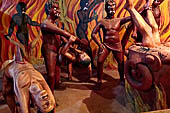
|
Buddha images
Shown in all of the canonical poses, mudras, Buddha images present some Sinhalese features like the ushnisha, the small protuberance on the top of the head denoting superior mental powers (Gal Vihara - Polonnaruwa), the siraspata, the flame of wisdom (Wewurukannala), or the feet decorated with 32 different auspicious markings (cave temples). The gigantic Buddha statues denotes a Mahayana influence that views the Buddha as cosmic being rather than the truly human Buddha of the Theravada Buddhism (Wewurukannala).
The majority of reclining Buddha images are shown in a "sleeping pose" distinguished from the true parinirvana mudra by the open eyes and the aligned toes of the two feet. An example of a ‘true’ paranirvana mudra is the 14m long reclining Buddha of Gal Vihara Polonnaruwa where the Buddha is shown with closed eyes and with the upper foot slight drawn back.
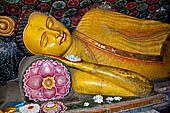
|
Aluvihara
|
The dragon arch, 'makara-torana', can be commonly found above doorways and Buddha images. Of Hindu origin, this ornamental arch springs from two facing makaras, the mythical creature made of elephant’s trunk, lion’s legs, crocodile’s teeth, fish’s body and Garunda’s wings. In the middle of the arch, in the keystone position, there is the Kibihi face (cave temples).
Mulkirigala cave temples |
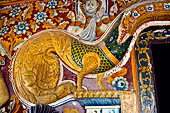
|
The Balustrades, ‘Korawak gala’ are present on entrance stairways and steps, they are sometimes called Dragon Stone (Makara Gala), the imaginary animal represented is made up of six parts: the trunk of the elephant, the jaws of the crocodile, the teeth of the wild boar, the feet of a lion (beautiful example in the vatadage Polonnaruwa).
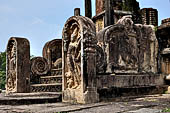
|
Polonnaruwa
|
Stairways are often flanked by guardstones (doratupalas or dvarapalas) with the protective anthropomorphic cobra-king nagaraja carved in a gracefully posture and princely dressed and ornamented. In one hand the nagaraja holds the pot of plenty (punkalasa) and in the other a sprouting branch with flower buds and leaves. Around the head there is a multi headed cobra hood (five, seven and occasionally a nine-headed cobra hood). At the feet of the nagaraja there are two pot-bellied dwarfs attendant (gana), derived from the ‘yaksas’ protectors of the treasure of God Kuvera (guardstones of the Vatadage in Polonnaruwa).
Polonnaruwa |
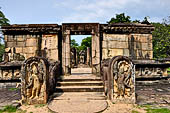
|
Dwarfs can also be seen in low relief carvings at the base of steps and on temple walls together with elephants, lions (emblem of the Sinhalese people), and geese (the symbol of spiritual knowledge).
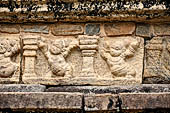
|
Polonnaruwa
|
The semi circular threshold slabs called moonstone (sandakada pahana) are the Sri Lanka architectural characteristic. Carved in concentric half-circles they concentrate the mind of the worshipper upon entering the temple. In general the animals of the four direction (lion, ox, elephant and horse) are present in separate or combined rings with at the centre the lotus, in other designs flames, swans and other floral patterns are also present. In later design the moonstone takes different shapes (the triangular moonstones of Dalada Maligawa - Kandy), also the carvings become varied with the symbolic religious meaning totally forgotten.
Polonnaruwa |

|
| |
|
|
 |
|
|



